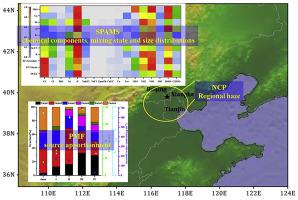Atmospheric Pollution Research ( IF 4.5 ) Pub Date : 2020-05-18 , DOI: 10.1016/j.apr.2020.05.010 Lijuan Shen , Honglei Wang , Wenkang Gao , Yuan Yang , Wei Huang , Lili Wang , Renjian Zhang , Jianan Zou , Dongsheng Ji , Yuesi Wang

|
Regional haze pollution can normally be divided into four stages comprising pre-accumulation, explosion, duration and dissipation, under which the physiochemical characteristics of aerosols were clearly distinct. In this study, the chemical compositions and mixing state of aerosols and their source apportionments during a regional haze pollution process in the North China Plain (NCP) were comparably discussed for the different haze evolution stages. Six main particle groups were identified, including carbon-rich particles (53.17%), K-rich particles (27.41%), heavy-metal particles (10.9%), sodium particles (5.61%), dust particles (1.62%) and ammonium particles (1.29%). Subsequently, the chemical components and size distributions of aerosols were found to vary during the different haze stages. Contrary to the OCEC, K–CN, Cu and Pb particles, the EC-nitrate, EC-secondary and Fe particle groups had increasing proportions with the development of the haze events. The fraction of K particles was higher during the pre-accumulation stage and descended rapidly during the subsequent haze stages. In contrast to the OCEC particles, the EC-nitrate and EC-secondary particles from 0.6 to 1.2 μm increased significantly with haze deterioration, implying the enhancement (decline) of aged (primary) carbonaceous particles during the haze episode. The source contributions of PM2.5 changed with the evolution of the haze events, with the largest percentage up to 52.23% from residual and industry emissions during the explosion stage. In contrast to industry and direct combustion emissions, the aging process and traffic emission contributed increasingly with the aggravation of the haze episodes, with higher fractions of 33.17% and 15.57%, respectively, throughout the duration stage.
中文翻译:

单颗粒气溶胶质谱仪在局部霾天气中城市气溶胶的实时物理化学:混合状态,尺寸分布和源分配
区域雾霾污染通常可分为四个阶段,包括预积累,爆炸,持续时间和消散,在这四个阶段,气溶胶的理化特性明显不同。在这项研究中,比较了在不同雾霾演变阶段华北平原(NCP)区域性雾霾污染过程中气溶胶的化学成分,混合状态及其来源分配。确定了六个主要颗粒组,包括富碳颗粒(53.17%),富钾颗粒(27.41%),重金属颗粒(10.9%),钠颗粒(5.61%),粉尘颗粒(1.62%)和铵颗粒颗粒(1.29%)。随后,发现在不同的雾度阶段,气溶胶的化学成分和尺寸分布会发生变化。与OCEC,K-CN,Cu和Pb颗粒相反,随着雾度事件的发展,硝态碳酸盐,次生碳酸盐和铁颗粒的比例增加。在预积累阶段,K颗粒的比例较高,而在随后的雾霾阶段,K颗粒的比例迅速下降。与OCEC颗粒相比,随着雾度的降低,从0.6至1.2μm的EC硝酸盐颗粒和EC二次颗粒物显着增加,这意味着在雾霾发作期间,老化的(原生)碳质颗粒会增强(下降)。PM的来源贡献 2μm随雾霾恶化而显着增加,这意味着在雾霾发作期间老化(主要)碳质颗粒的增强(下降)。PM的来源贡献 2μm随雾霾恶化而显着增加,这意味着在雾霾发作期间老化(主要)碳质颗粒的增强(下降)。PM的来源贡献2.5随霾事件的发展而变化,在爆炸阶段,残留和工业排放的最大百分比高达52.23%。与工业和直接燃烧排放相反,老化过程和交通排放随着雾霾发作的加剧而越来越多,在整个持续时间阶段分别占33.17%和15.57%。


























 京公网安备 11010802027423号
京公网安备 11010802027423号